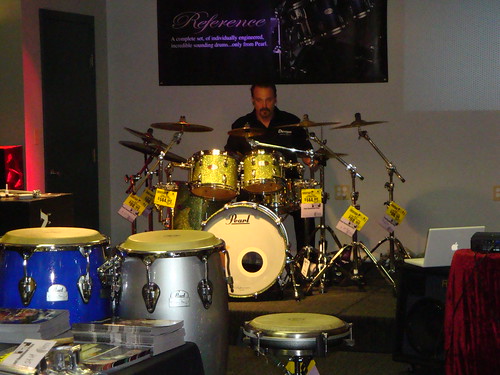
Image : http://www.flickr.com
In this part we will be looking for a cut down, and mixing football and bass drum.
Low Cut
First, you want to add a low-cut filters on every track, except the bottom. You can use these wherever you want, but should not be less than 90 Hz, as there are other frequencies interfering with the bass. With approximately 200 Hz, you will start losing punch, 3-400, and is cut muddiness.
Mixing the Kick With the addition of a low-cut to 70/100hz,Using aggressive compression at a ratio of 6 to 8:1, and a very fast attack (from 1.5 to 3.5 ms), with about 8DB gain reduction, so the addition of a Mid Boost 3/4DB (3-5kHz standing) and boost (6-8kHz), the case is much more in the dubstep mix. Power Tip: When using compression for the attack may dubstep most important factor. The most common error when people are starting to think that is the very attack that the sound is improved, but the function of attackactually have control over how fast the compressor starts to work, actually a long attack on a powerful sound and will not affect compression.
Through the use of 1-4 ms by dubstep dubstep kicks and snares so they are natural "snap") the tone (in milliseconds before the compressor starts and then compresses the rest of the sound. The bass drum is the 2nd most important element of a dubstep track and was the strongest part of 0dB peak on a desk and digital3 DB on an analog desk. It may be strange, in between, and tips on adding a bass "drum sound, 'but if you listen carefully, a classic 909 kick, you will notice much of its impact is actually in the higher frequencies, go ahead and perform a low pass filter on a 909 and you will see that is pretty pathetic up. It took a while 'to learn, I did happen to my kick down to about 200 Hz and has never been received, it sounds good.
That was because I had taken all the energy ofBass. Here are the attributes of the drum are the boom: This is the bass, which takes in the belly, is about 80-110Hz The Smack: This is the area of attack and the area to hear that most of the stops as the definition matches found in 3-5kHz area, I tend to make relatively high up to 5 or 6 dB, with a big D. The Click: This works with the use of the smack and the massive support for the establishment of a bass drum in the mix, which is located in the 6 to 8 kHz, again a strong increase in this areaworks well to define the drum. The peat surface: a thin band between 250 Hz to 300Hz can be effectively removed all the unwanted mud (mud and especially the clarity of the UN) recipes compression: to strike hard: the ratio 8: 1, 10dB gain reduction, 3ms attack 200ms Release In Your Face: 6:1; 8dB gain reduction, 2.5ms attack 200ms release subtle: 3:1, reducing the gain 6 dB, 4ms attack 200ms Release Mixing the Bass: Good starting point is that an EQ to remove any muddy andThere have been slight increase in your take on more.
If low light than playing football with a cut up, removed the upper end, where the lower end. Then, the equalized signal to a compressor with a ratio of about 4:1, fast attack, and reducing the gain of 4dB. Avoid contact with the spirit that you can not EQ the sound in a certain way because it sounds different from how it should sound, he is also working with football and a private room or the resultA messy end with the lower call rate. You can hard / dirty dance music, good product and has a good separation. The subgroup of low ranging from 30 - 60 Hz, but may slip as 100Hz. Try to get under the law, as sub sounds too bad on a system of small, but it might cones or amplifier, and a larger shock. A good way to check is to listen through headphones and long term for a few seconds before it should, football makes it buzz,and the sub so that they buzz the same amount. If you are really busy due to go on the low notes as pause, then roll some areas with a lower shelf 49khz with 2 or 3 dB of gain reduction removes the excess energy in the region of sound. There is now a good idea to add a hi open, has set a gross volume, and then listen to see if there are harmonics that there is between the real and the Netherlands are the hats. If it againParametric EQ catch the bass frequencies and out.
No comments:
Post a Comment